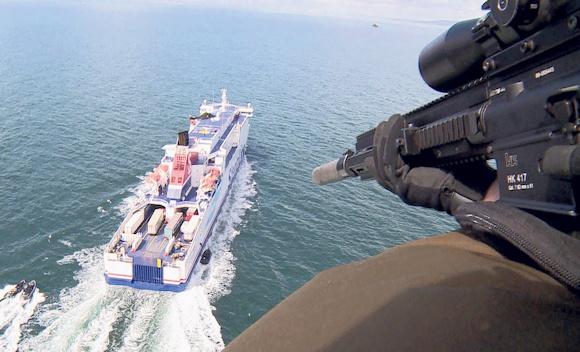In the millennial history of the art of "War on the Sea" and naval battles, the technique of adherence has always maintained the particular aspect of having to go, even in the high seas, yet to seek physical contact with the enemy to destroy it. In fact, when the naval battle involved the landing, after a first phase of distance combat, generally carried out with a furious and fierce artillery fire carried by the cannons on board, it was a second phase of approaching and supporting ships to allow the real assault carried by the sailors who fired, weapons in hand, on the enemy ship.
In maritime terminology, the word "landing" means "to pacify the edges of two ships", that is, the flanks. This edging of the edges also allowed to support the appropriate wooden boards that allowed the passage of sailors from one ship to another ("deck bridge") to engage body-to-body combat with the enemy directly on deck decks , without having to go from trees or pennons. Moreover, in the ancient Genoese language, "leaning" was said to be "embalmed", from which the term "arrembaggio", the term with which it is more properly understood, that particular tactic of naval assault combat (carried out with sailors, sailors or soldiers) of an enemy ship to capture, plunder and / or sink it, depending on the order received.
Modern naval doctrine makes no difference between "boarding" and "engagement", ie between "boarding" and "assault", and only uses the more delicate concept of "Boarding", which is the same term that is normally used in (both airport and port) to indicate generally the "boarding" action, that is, boarding a plane or a ship.

A specially trained military team to carry out an arena is internationally referred to as the "Naval Boarding Party", commonly known as the "Boarding Party" (BP / BParty), and is numerically constituted by no less than 12 men, while a group consisting of fewer men is called "Boarding Team" (BT / BTeam), or "Team of Arrampage". The consistency of the teams is variable, as the teams may also be present, depending on the assigned mission, different "support figures" (video-operator for resuming the whole action, demolisher with relative intrusion / burglary / cutting / breakdown, expert on board documents, expert on maritime law, nurse, trained prisoner, sniper, sniper ...).
In general terms, the BParties, since the end of the 90 years, have been used in different scenarios and in increasingly demanding missions, from those where it was expected to have a pure adherence to those of arrears until they came to those of a real assault . Without going into the principles relating to the "freedom of the oceans and seas" or the complex legal and juridical implications of Maritime International Law on "Security" (understood not only as "Safety" but also as "Security"), recall that the so-called International Community, after the famous 11 September 2001 bombing, has finally decided to adopt new and more intensive measures to ensure the so-called "Maritime Security" by allowing a new vision of "preventive defense" to prevent, counteract and cancel any acts of terrorism, sabotage, piracy and hijacking of ships. In this context, all those military operations aimed at eliminating possible risks or countering and hitting the various threats arising from maritime affairs, illegal trafficking, criminal activity to piracy or terrorism, are dictatorially defined as "Maritime Security Operations "(MSO), or" Maritime Security Operations ".
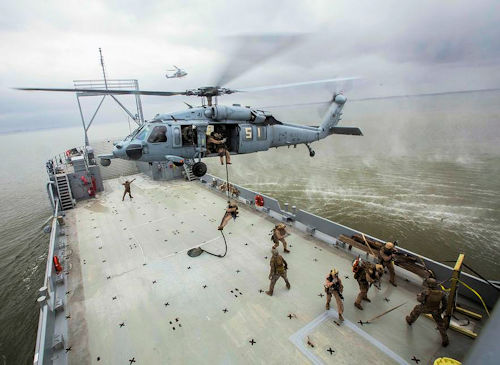 MSOs are naval operations that envisage a wide variety of missions of both "military" and "constabulary" missions. The military is inherent in Anti-Terrorism, Operations Forces or Merchandise Naval Protection, Anti-Piracy, Intelligence and "Presence and Surveillance" activities while constabulary ranges from criminality or criminality to the application of rules of International Maritime Law (for example, the exercise of "right of visit" or "right of pursuit"). In the broader context of MSOs, there are also Maritime Interdiction Operations (MIO), Maritime Interdiction Operations that, depending on the needs, of the objectives to be achieved, the interests to be defended and the collaborative or coercive levels that are present, they can also be regarded as military or constabulary. Incidentally, "Maritime Interdiction" should not be confused with classical "naval interdict", which identifies the various war activities aimed at slowing down, stopping or destroying enemy forces (or their supplies) before they reach the battle zone . The MIOs we are talking about initially emerged as maritime trade surveillance operations designed to enforce coercive naval embargoes through the application of certain measures / measures of interdiction. Subsequently, they have been expanded to counteract acts of "maritime sea terrorism", using naval vessels (or "military ships" and then Marina), which act as "Coastal Maritime Terrorism", employing coastal units (ie the Coast Guard and / or the Police). My Mio, if implemented following a resolution of the UN Security Council, makes the definition of "Maritime Interception Operation". The BParties have therefore become the appropriate military tool used to carry out these operations to prohibit the navigation of particular sea areas or to identify suspect ships, to stop it, to visit it, to inspect it and eventually capture it and to divert it to safe harbors to proceed or further inspection or final seizure. Because of the above, BParty is often referred to as "VBSS" or "Visit, Board, Search and Seizure" (visit, boarding / retrieval, search / inspection, and capture / seizure). The Boarding Parties / Teams are therefore the essential tactical component for carrying out all those missions where it is anticipated or necessary for several reasons to board a ship or boat.
MSOs are naval operations that envisage a wide variety of missions of both "military" and "constabulary" missions. The military is inherent in Anti-Terrorism, Operations Forces or Merchandise Naval Protection, Anti-Piracy, Intelligence and "Presence and Surveillance" activities while constabulary ranges from criminality or criminality to the application of rules of International Maritime Law (for example, the exercise of "right of visit" or "right of pursuit"). In the broader context of MSOs, there are also Maritime Interdiction Operations (MIO), Maritime Interdiction Operations that, depending on the needs, of the objectives to be achieved, the interests to be defended and the collaborative or coercive levels that are present, they can also be regarded as military or constabulary. Incidentally, "Maritime Interdiction" should not be confused with classical "naval interdict", which identifies the various war activities aimed at slowing down, stopping or destroying enemy forces (or their supplies) before they reach the battle zone . The MIOs we are talking about initially emerged as maritime trade surveillance operations designed to enforce coercive naval embargoes through the application of certain measures / measures of interdiction. Subsequently, they have been expanded to counteract acts of "maritime sea terrorism", using naval vessels (or "military ships" and then Marina), which act as "Coastal Maritime Terrorism", employing coastal units (ie the Coast Guard and / or the Police). My Mio, if implemented following a resolution of the UN Security Council, makes the definition of "Maritime Interception Operation". The BParties have therefore become the appropriate military tool used to carry out these operations to prohibit the navigation of particular sea areas or to identify suspect ships, to stop it, to visit it, to inspect it and eventually capture it and to divert it to safe harbors to proceed or further inspection or final seizure. Because of the above, BParty is often referred to as "VBSS" or "Visit, Board, Search and Seizure" (visit, boarding / retrieval, search / inspection, and capture / seizure). The Boarding Parties / Teams are therefore the essential tactical component for carrying out all those missions where it is anticipated or necessary for several reasons to board a ship or boat.
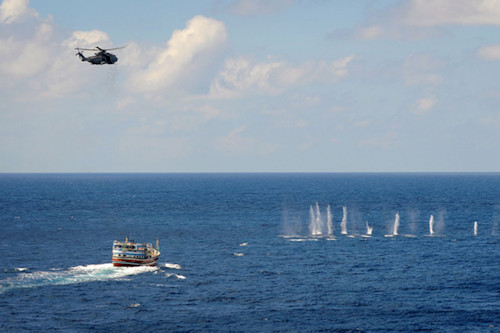 A boarding action can be developed mainly in two possible situations that are identified by the attitude, friendly or not, demonstrated by the ship that is about to be boarded. The action can then be done in terms of doctrinal terms of a defined "Compliant Boarding" context, or in a non-compliant / non-permissive boarding environment. In the case of a "hostile environment", it is hoped that you will be able to count on Wage Rules that allow you to proceed directly with the assault of the ship ... without much compliments. From a tactical point of view, "boarding" can be done by means of different execution modes which are mainly determined by meteomarine conditions (sea, wind, rain, visibility), available means (naval unit, rigid tugboats and helicopters ), the type and characteristics of the board to be boarded (function, type of load, free edge height, superstructures present, maximum expressible speed, type of propulsion and steering organs) and the time available to carry out the entire operation. The choice between the different modes of execution is also influenced by the ability to employ the means depending on the opportunity / tactic necessity, as well as any constraints, which will propose different operational configurations depending on who provides fire protection (naval unit, helicopter or both) and the vehicle (s) with which boarding (1 or more pneumatic, 1 or more helicopters) is performed.
A boarding action can be developed mainly in two possible situations that are identified by the attitude, friendly or not, demonstrated by the ship that is about to be boarded. The action can then be done in terms of doctrinal terms of a defined "Compliant Boarding" context, or in a non-compliant / non-permissive boarding environment. In the case of a "hostile environment", it is hoped that you will be able to count on Wage Rules that allow you to proceed directly with the assault of the ship ... without much compliments. From a tactical point of view, "boarding" can be done by means of different execution modes which are mainly determined by meteomarine conditions (sea, wind, rain, visibility), available means (naval unit, rigid tugboats and helicopters ), the type and characteristics of the board to be boarded (function, type of load, free edge height, superstructures present, maximum expressible speed, type of propulsion and steering organs) and the time available to carry out the entire operation. The choice between the different modes of execution is also influenced by the ability to employ the means depending on the opportunity / tactic necessity, as well as any constraints, which will propose different operational configurations depending on who provides fire protection (naval unit, helicopter or both) and the vehicle (s) with which boarding (1 or more pneumatic, 1 or more helicopters) is performed.
The naval unit from which Boarding is operated, or from which the entire operation is operated and controlled, from which the BParty is part of which is always provided fire protection by means of the on-board weapons, is defined as "Boarding Ship". This unit also has the prerogative to establish how to approach the ship to be boarded (the "Target Ship" -TS), its eventual pre-positioning, eventual radio contact, in case of collaborative boarding, with the Target Ship (alternatively, light flash or megaphone), whether it is underway / steaming or stays in the midst of the sea (static / floating).
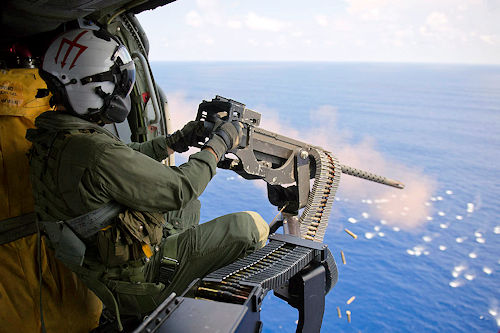
The first real difficulty, leaving out the meteorological conditions that could make a boarding unsuitable, is the one where it occurs when the ship to be inspected does not intend to stop and get boarded back in full to a "non-collaborative" situation. At this point, "WS: Warning Shots" are needed by using cannons, machine guns or machine guns. If the vessel does not stop, somehow it must be blocked and then boarded.
Methods to stop a ship, without having to be over-damaged, must necessarily either act on steering organs (rudders, propellers or their respective axes) or propulsion bodies (motors, turbines, engine rooms, power stations). In this regard, two methods are used. First method: Lock the propellers with a "trap cable" (PERT: Propeller Entangler Rope Technique). The Boarding Ship, which has already appropriately prepared and "dotted" an impeller entangled cord (raffia), or an impeller entangler steel-wire, of adequate length (at least 100 / 200 meters) it must maneuver at high speed to cut off the ship's path to be blocked, passing at a very short distance, and at the same time "strut the sea" with the trapping cable. The ship to be approached, even counterclockwise, can not avoid finishing with the propellers on the cable, which, by fastening at least to a propeller shaft, will lock the shaft itself, and then propulsion. Moreover, freeing the axis of a propeller wrapped tightly by a cable is a good undertaking, even in calm sea conditions. If the cable turns out to be a steel screwdriver, you also need a specialized diving specialist to use a specific hydraulic shears or cutting tools (ossieelectric cutter, thermal sprayer, saw saw). Second method: shoot to damage the organs of government and / or propulsion; this technique is called "DF: Disabling Fire" and is carried out by boarding ship or by a helicopter in hovering by using anti-collision / anti-aircraft guns or rifles by firing on the Target Ship to directly strike the engine zone and / or rudders. Incidentally, this technique is not called a "stop fire" to not be confused with a specific fire defense action that is carried out in land-based shooting (exceptionally in artillery shots).
 As for the approaches and "insertion" actions in the BTeams operation area, two types of vehicles are used: Rigid Hull Inflatable Boat (RHIB) and helicopters, all suitably configured for boarding and prepared for the so-called "vertical insertion" of the BTeams: bottom upward entry from the point of uphill from the boat to the ship (HCBT: Hook and Climb Boarding Techniques, or Climbing Boarding Techniques coupling), and from top to bottom with respect to the descent from the helicopters on the ship (VIBT: Vertical Insertion Boarding Techniques).
As for the approaches and "insertion" actions in the BTeams operation area, two types of vehicles are used: Rigid Hull Inflatable Boat (RHIB) and helicopters, all suitably configured for boarding and prepared for the so-called "vertical insertion" of the BTeams: bottom upward entry from the point of uphill from the boat to the ship (HCBT: Hook and Climb Boarding Techniques, or Climbing Boarding Techniques coupling), and from top to bottom with respect to the descent from the helicopters on the ship (VIBT: Vertical Insertion Boarding Techniques).
As already mentioned, there are 2 boarding typologies that are identified by the alleged "Types of Collaboration" that can be provided by the Target Ship: Compliant Boarding (CB) or Non Compliant Boarding (NCB). For full information, these types of collaboration should consider 4 as possible Resistance Levels: Collaboration / Non Resistance (1 Level), Non-Collaboration (2 Level), No Complex Collaboration (Level 3), Opposition / Ostility ( Level 4). Some Marine inserts these assumptions into a matrix that should provide help for the boarding decision to be made. All in all, the results provided by that matrix can be largely overcome by the use of common sense! Of course, one important factor to consider is the height of the ship's sideboard to board, ie if it has a high wall (high freeboard, high freeboard, if it is larger than 25 feet) or a low wall (low freeboard, if free lower than 25 feet). Obviously an account has to be approached by a fishing star (the famous dhow) of thirty meters and a few hundred tons of tonnage with a free margin of maybe 3 meters and another account and having to board a long container ship some hundreds of meters, hundreds of thousands of tonnes of tonnage and with a free edge of over 8 meters (25 feet). Boarding can be implemented with RHIBs, helicopters, or generally simultaneous use of both vehicles ... plus an eventual helicopter for the cover fire.
 Boarding performed with one or more RHIBs
Boarding performed with one or more RHIBs
If Boarding is collaborative, it will be the same Target Ship to drop a biscuit down to the boat, or lower a catwalk to allow BParty to board. If boarding is not collaborative, BParty has to see it alone on how to board, or rather, climb on board. And so the technique is used with the "ramp", or hand-launched with a weaver or outlined with a special long telescopic rod. In fact, once the pneumatic boat flies to the wall of the ship, it must remain "glued" even with moving and big sea vessels, so that a ramp can be launched (for the subsequent engagement of a special biscuits / biscaglina) or the attachment of a rod equipped with pegs or the engagement of a ladder that, when taken on the superstructure of the ship, will allow a BParty operator to board and put him safely " climbing equipment "to allow the next climb to the whole group. All of this happens, of course, with the "cover" provided by the Boarding Ship, a helicopter or another boat. The various techniques are directly related to the equipment used for "coupling and climb" and can be summarized as follows: direct use of a special telescopic rod already provided with hooks and steps for immediate engagement and climbing (THBR: Telescopic Hooked (Boarding Rod), direct use of Telescopic Hooked-Up Boarding Rigid Ladders (THBRL), HGH (Handled Grappling Hook) or use of a telescopic rod with ramp (TGH: Telescopic Grapnel Hook) for the next FHL (Flexible Hanging Ladder), using a special Grapnel Hook Gun / ALM: Assault Launcher Max. The climbing / climbing techniques can be summarized as follows: Climbing techniques with rock climbing techniques (TAAD: Tactical Assault Ascender-Descender / ACTSTA: ACT Safe Tactical Ascender) climbing through Ladder / Jacob's Ladder, climbed via Fixed Pilot Ladder, Gangway.
Boarding with one or more helicopters

The use of helicopters for infiltrating and / or extruding men into or from an area considered hostile or hostile has been widely verified in the Vietnam and Falkland / Malvinas war contexts. From these experiences, 4 techniques were selected: STABO, SPIE and HRST in two versions (Rappelling / Abseiling and Fast Rope). As far as boarding operations are concerned, the most appropriate technique is the Fast Rope, defined in Italian as "Barbettone" or "Canapone": it is a technique that does not require slings or carabiners as it is a simple single synthetic rope (Diameter not less than 4.4 cm.) On which to slide quickly, holding hands and feet firmly, to the ground (or on a vessel's jacket or container). With a stationary flying helicopter, at a height that can vary from 5 to 15 meters from a ship deck, this technique allows, in a matter of seconds, a very fast downhill and a single rope of a whole BTeam. In addition, the weight of the rope itself also ensures a certain degree of descent stability in the turbulent air vortex generated by the helicopter blades.
For educational purposes, a generic collaborative boarding is now described, the purpose of which is to inspect an on-board merchant ship, navigating on the sea, in search of an alleged illegal / dangerous cargo within the ship itself. The tactical concept develops in the following points: the BParty is armed and then divided into BTeams who embark on the embarkation on RHIB and helicopter; the ship is contacted by radio and instructions for boarding are provided. At that moment you can already guess whether it will be a collaborative Boarding or not; bargain and guide the weapons (cannons, machine guns and machine guns), ready to make warning shots, overturning fire or incapacitating fire; the commander is invited to remain onboard only with the helmsman, only to leave the machine director and a technician in the engine room and to center the crew in a single easily controllable room (usually in the canteen area by temporarily delivering all mobile phones); boarding operations are started; The BTeams, once on board, will further subdivide to control the dashboard, the engine room, the radio room, the room where the theoretically is centered throughout the crew and to inspect the entire ship. The BTeams will proceed to accurately inspect the ship's various venues in accordance with the tactical and tactical movement procedures on the ground that are generally used in the perturbation of the inhabited centers, and are also ready for a possible body-to-body combat; After inspection, the exfiltration is generally re-embarked on the entire BParty on the RHIBs which then proceed to boarding the Boarding Ship.
Rev. Admiral Marco Bandioli
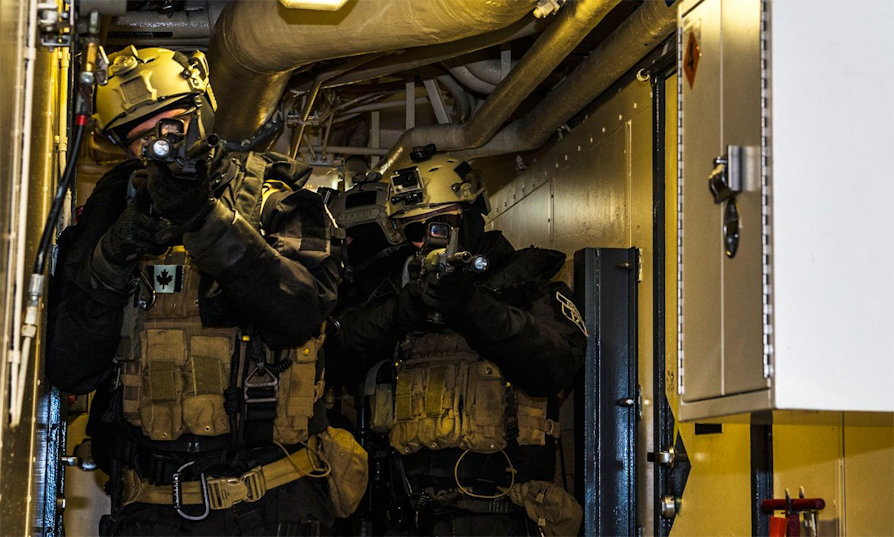
(photo: web)

